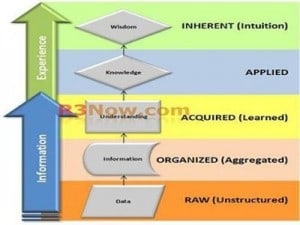One driver for this continuing Series on SAP Competency Center or SAP Center of Excellence is the desire for so many senior IT leaders to become future-state business strategist CIOs. The last post provided the introduction of SAP Enabled Business Transformation for IT Leadership, a key requirement for senior IT leaders to become strategic business peers.
Additionally, that post introduced the three key milestones on the journey to the future-state business strategist IT leader– especially if you want to become a CIO. In 2010, the CIO Executive Council conducted a study of some 200 selected business leaders. They wanted to “identify goals, challenges and best practices among a representative population of top IT leaders.” The survey indicated that 80% of these leaders wanted to advance to the “future-state, business strategist CIO position.” As the last post addressed, this objective requires three stages that IT leaders must move their organization through: internal focus, enterprise focus, and external focus. In terms of organizational maturity, this means going from service provider to business partner to business peer.
The reason I focus on the SAP Center of Excellence concept [FN1] is that the model provides any transitioning or transforming IT organization with an understandable future state to work toward. That future state is also why maturity models have become so popular. Maturity models, such as the SAP Center of Excellence, provide a roadmap to build the structure around for reaching your destination.
Beyond a mountain of SAP service providers pushing for outsourcing, you find little information about building, maintaining, and then delivering excellence in a live SAP organization.
The Internally Focused SAP IT Organization
– The Internal IT Focus correlates to the basic IT service provider model.
To summarize, the Internal IT Focus is IT leadership’s concern with system stabilization, fixing problems, and addressing any high priority changes or needs. At this point, your SAP IT Organization activities are all about the care of the new SAP system: basic system maintenance and support. Some commentators refer to this as “keeping the lights on.”
At this stage, the critical SAP IT organization development activities include the following:
- Gaining functional competence with the SAP applications (maintenance for the support staff, providing further training and knowledge transfer for end users),
- Developing leadership skills to manage internal SAP/IT initiatives (SAP project management, team leadership, blueprinting, scoping, estimating, etc.),
- Proper data management (data governance, correction, and ongoing refinement),
- Managing system security,
- SAP Help Desk and support operations, and
- Maintaining hardware/system responsiveness.
The IT Leadership Domain in this area is as functional head or basic management.
Many organizations are eligible to receive the SAP Certified Customer Center of Expertise designation at this point. However, this is only a service provider model and offers little value to the business.
The Business-Aligned SAP IT Organization
– Enterprise Integration is where the IT organization transitions from service provider to business partner through change management and organizational transformation.
The second key competency is Enterprise Integration, or, as many previous commentators have called it, “business to IT alignment.” However, Enterprise Integration goes Beyond Technology Alignment. At this stage, the IT organization is beginning to develop a level of business understanding and awareness as it takes the first steps to business integration.
The biggest problem at this stage is system integrators and staffing firms who promote the business and technical divide by providing resources who are clearly not real consultants. To get past this, you as the customer are responsible for FIXING Stupid SAP Vendor – Partner Selection RFI – RFP Processes and using Screening and Interview Methods to Find the Right Consultant – Part 2.
Think about it for a moment: If your SAP implementation vendor provides consultants who do not even understand business and may have other barriers to consulting, do you expect your own internal IT organization to magically bridge the gap? The internal resources generally have limited or no SAP exposure.
At this stage, the critical SAP organizational development activities include the following:
- More direct interaction with business users, supervisors, and business leaders (earning trust)
- Participating in resolving business challenges by offering technology options to help the business address their concerns
- Speaking in business terms about technology solutions
- Collaborating with business users across different departments to solve complex or interrelated challenges and problems (for one method to do this with SAP, see SAP, ERP III, SOA — Learning Organizations through Social Media Collaboration)
- Overall Change Management leadership by the IT organization
- Investment in training and development around organization change management
- Leadership/Management training of IT employees
- Periodic “shadow” or “employee exchange” programs for SAP employees to perform various business functions from the end-user and supervisory perspective
- Regular IT meetings (generally weekly) on how the company is applying technology to vision, strategy, and business goals
- Regular meetings (generally monthly) with various business stakeholders to show their progress of applying technology to the previously mentioned goals. This is part of the Steering Committee Governance for an SAP Center of Excellence and why Using Your SAP Steering Committee for Business Transformation is critical for SAP program success.
The IT Leadership Domain in this area is as a transformational leader with heavy organizational change and integration.
What about External Focus for the SAP Organization?
The IT Leadership Domain in this area is strategic leadership with a heavy emphasis on external market forces, sales, revenue generation, and improved company products/services.
We will look at some of the key activities related to the final step on this journey in a future post. In the final step, we change the divide between business and IT. This way, the company views the SAP support organization as a business peer, respecting and even seeking them out for their strategic contribution to overall business direction.
======================
[FN1] For context, Michael Doane and I used to work together at Grant Thornton in the late 90’s on SAP projects, and we have periodically stayed in touch since. Doane is one of the original advocates of approaching SAP implementations from the perspective of planning for the long-term use of the system rather than just getting through a project. He refers to this approach as building a “Center of Excellence” for the productive SAP instance.







Very Informative post.. The points you have explain is too good…